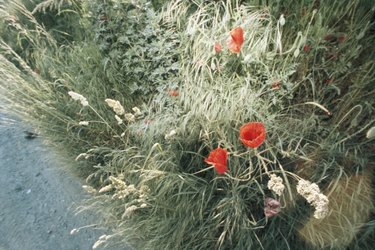
Many think of the poppy (Papaver) flower as a symbol of valor growing magically in the fields of Flanders and memorialized in Dr. John McCrae's poem "In Flanders Fields," a tribute to the Allied soldiers who gave their lives in World War I. Of the many types of poppies, the red-faced corn poppy (Papaver rhoeas) is the most recognizable and, like all poppies, one of the easiest flowers to grow from seed. Some poppy varieties are annuals like the corn poppy, while others are perennials. Climate dictates the length of time it takes a poppy to grow.
Planting Suitable Poppy Varieties
Video of the Day
Your area's U.S. Department of Agriculture hardiness zone is your first clue when considering the types of poppies that grow most successfully in your region. Poppies are found extending from above the Arctic Circle down to the southernmost part of Africa. Most grow best in the Northern Hemisphere, but that is where the similarity stops for the over 120 species of Papaver poppy, not to mention the California poppy (Eschscholzia californica) and the Celandine poppy (Stylophorum diphyllum).
Video of the Day
Red poppies, also known as Flanders, corn and field poppies, originated in Mesopotamia and then appeared in southern Europe, southern Asia and North Africa. These varieties germinate best in the warmer zones 4-9, as does the California poppy, originally from Mexico and the Southwest deserts. Cool, mountainous areas with snowy winters are preferred by Oriental poppies, while the Celandine poppy is a favorite of America's East Coast gardeners with woodland gardens.
Poppy Growth Rate From Seed
The magic of the poppy is that, once the seeds are spread, they appear not only in your garden but in walkways, neighboring gardens and as far as the wind carries them. The seeds are miniscule and don't take well to transplanting once germinated. Do not overcrowd the seeds. Scatter them in a pattern you like, lightly step on top of them and let them settle in. Do not cover them with soil or mulch, as they need sun to germinate.
Sow the poppies from fall to early spring in a location where they will experience temperatures below 32 degrees Fahrenheit. This is called "cold seed stratification" and imitates a natural cold storage. The cold wet weather breaks down the hard shell of the seed, enhancing germination and leading to larger blooms. Seedlings appear when spring arrives and, depending on the variety, soil condition and growing temperatures, this should be between seven and 30 days.
The Bloomin’ Poppy
As the winter chill disappears and the weather warms, your poppy seedlings will shoot up almost overnight, blooming in late spring and early summer. A bud appears at the top of the stalk and within 90 days, the bud blossoms into a flower. Keep the soil moist but don't saturate the soil, especially when a dry spell hits. You want a slow, easy growth, not leggy poppies.
Annual poppies are the easiest to care for. You don't need to stake the tall stems, and deadheading isn't necessary. Once they've completed their cycle and the flowers fade, pull them up, shake them over the garden to release more seeds, and add the stems to your compost pile. The seed is viable for decades and lies dormant in the soil. Such were the flowers in Flanders Fields that appeared suddenly, heralding the valiant men who fought and died.